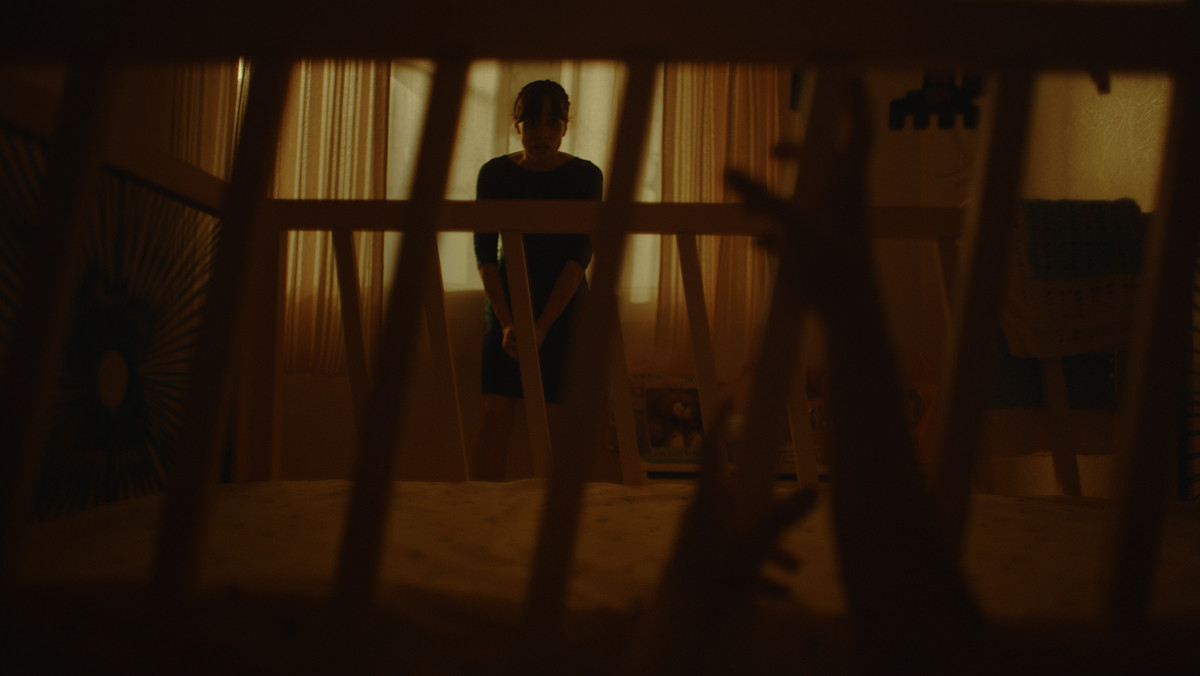In the horror movie Huesera, Valeria (Natalia Solián) wants to be a mother. She shows her devotion to this idea by making a pilgrimage to a shrine for Our Lady of Guadalupe to pray that the Virgin Mary bless her womb. A craftswoman who makes furniture for a living, Valeria eagerly awaits a positive pregnancy test with her boyfriend, Raúl (Alfonso Dosal), while building a crib for their future baby herself. Then something begins haunting her, a figure that takes on unnatural shapes and makes her feel like her bones are breaking. Maybe because, in some way, they are.
The directorial debut of Michelle Garza Cervera, Huesera — which translates to the film’s English subtitle, The Bone Woman — looks at motherhood through the lens of body horror. Other people’s expectations — which weigh heavily on any couple looking to start a family, but on the pregnant person the most — begin to infringe on Valeria’s peace of mind. But where Huesera stands out is in how its horror stems not from external pressures placed on Valeria, but in her expectations for herself.
Huesera’s script — which Cervera co-wrote with Abia Castillo — is methodical and clear, as a supernatural apparition quietly invades an intimate drama. Not long after getting pregnant, Valeria begins to see things — sometimes a spider, but more often, a faceless woman whose bones break as she crawls from shadow to shadow at the edge of Valeria’s vision. In a manner similar to The Babadook, the apparition is clearly symbolic, but also possibly real — a malign, unnamed spirit that only Valeria can see, causing her to act out in ways that make her family begin to question her mental health.
Photo: XYZ Films
While Huesera remains coy about the nature of its horrific presence, the film is less opaque about the part of Valeria’s past that it’s a metaphor for. As her pregnancy progresses, Valeria begins to quietly mourn the parts of herself that she gave up to pursue the vision of domesticity that she’s applied herself to so diligently, making meals for Raúl and building a nursery. She digs through a trunk of relics from her not-so-distant past, when she ran around with queer punks and loudly decried the traditional gender roles she now readily subscribes to. Huesera leaves the transition between punk Valeria and present Valeria to the viewer’s imagination. That’s largely to its benefit, because Huesera devotes its time to something a little more complicated than a shopworn story about a woman changed by impending motherhood.
There’s a focus on ritual in Huesera that builds both its horror and its character study in compelling ways. Its scenes are built around rituals of all kinds: its opening pilgrimage to the Holy Virgin, even as the sound of gunfire cracks through the woods around the shrine; the rituals of domesticity as Valeria and Raúl begin nesting, which are disrupted by the apparition; the art and noise of a punk show where Valeria begins to believe she’s trapped herself in a life she doesn’t really want; and in the folkloric rituals of witchcraft that women practice in private spaces, away from the prying eyes of church and patriarchy, where mothers and daughters bargain with unseen forces to wrest control over their fate.
Eschewing jump scares, Huesera instead relies on its protagonist’s interiority. The film is focused tightly on Valeria, and Natalia Solián carries the narrative burden with ease. Others fade in and out around her, but Valeria is the only character with a real arc; supporting characters mostly serve as foils and reflections, or roads not taken. Solián’s performance is understated, and it quietly raises a terrifying question about parenthood — if having a child is faking it till you make it, what happens if you never stop faking it?

Image: XYZ Films
Huesera speaks in a language of breaking and setting, as rigid structures crack under pressure — the wood of sturdy furniture, the bones of an animal consumed for its flesh, the expectations of a mother-to-be. Powerful hands pry these things from their assigned purpose. In Huesera, Valeria is both a craftsperson’s hands and their medium: shrieking in agony as her bones are bent in ways they were not meant to, yet longing for the control to contort her life into a shape molded by her desires. Cervera has crafted a motherhood fable that responds to tradition by asking: Which tradition is strongest and most empowering? The Catholic rigidity embodied by a sculpture of the Virgin Mary? The witchcraft of the women imprisoned by such ideals? The punks who rebel? When someone whose life is in transition gets pulled in so many directions, the body is transformed, and the bones are reset.
Huesera: The Bone Woman is in limited theatrical release and will be available on VOD on Feb. 16, with a Shudder release to follow.

